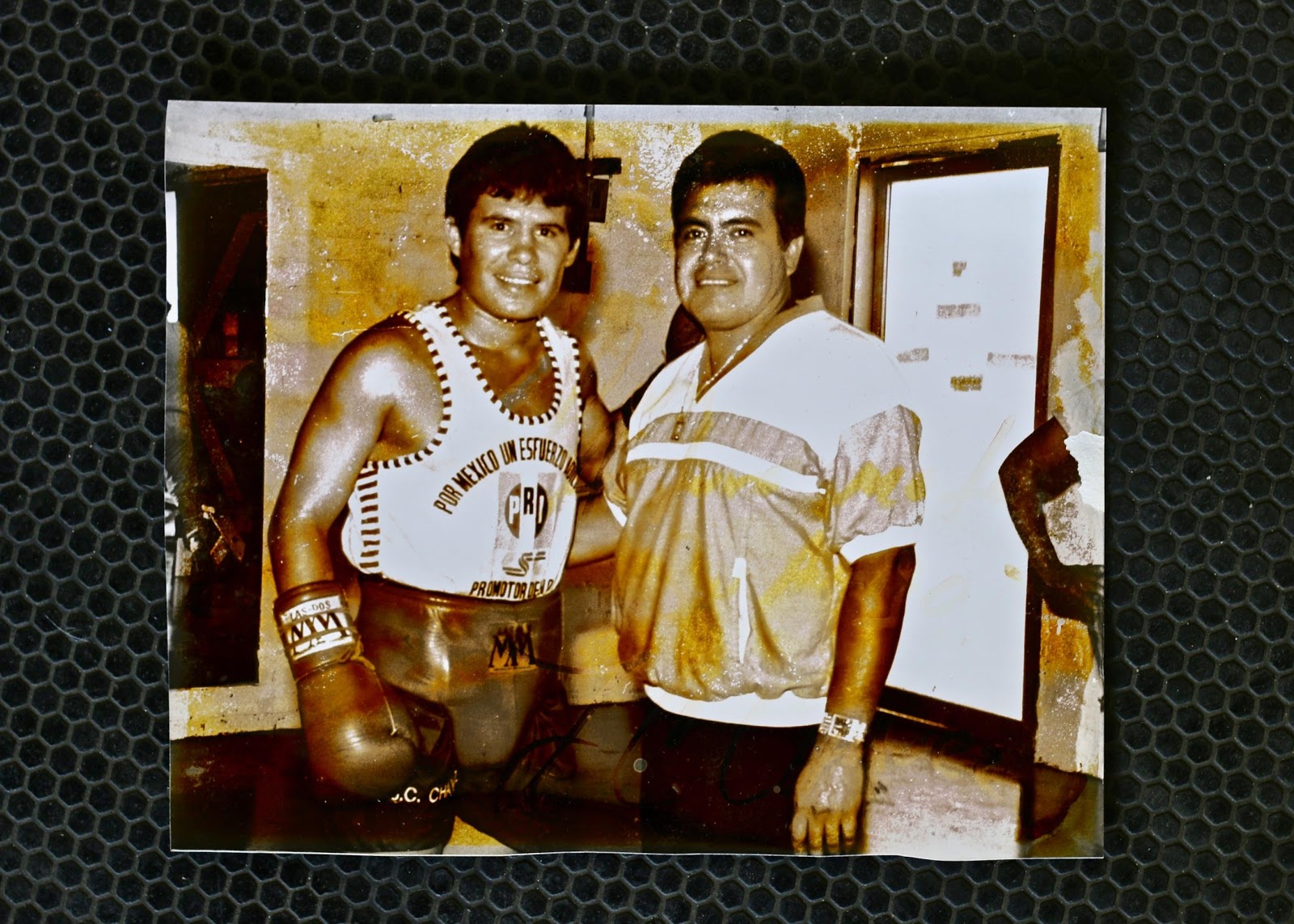[dropcap size=big]J[/dropcap]ulio Cesar Chavez was arguably the most famous Mexican athlete on the planet and he was hanging out in the city of Bell – punching the heavy bag, conducting media interviews, and taking photos with his adoring public – at a little known gym called Azteca.
Boxing greats like Chavez, Hector Camacho, and Maromero Paez all fought on the biggest stages in the sport of kings, and they all trained at Azteca. Now, you can ask any true boxing fan if they know about Azteca Boxing Club, and they will tell you it is just as legendary as the champions it helped make. And it all started thanks to a Mexico City transplant, a butcher named Arturo Mota.
Since 1980, Azteca has been serving pros and amateurs alike on Gage Avenue in Bell. But it was Chavez’s decision starting in the mid-80s to host open workouts there for the media and his fans that made it internationally renowned.
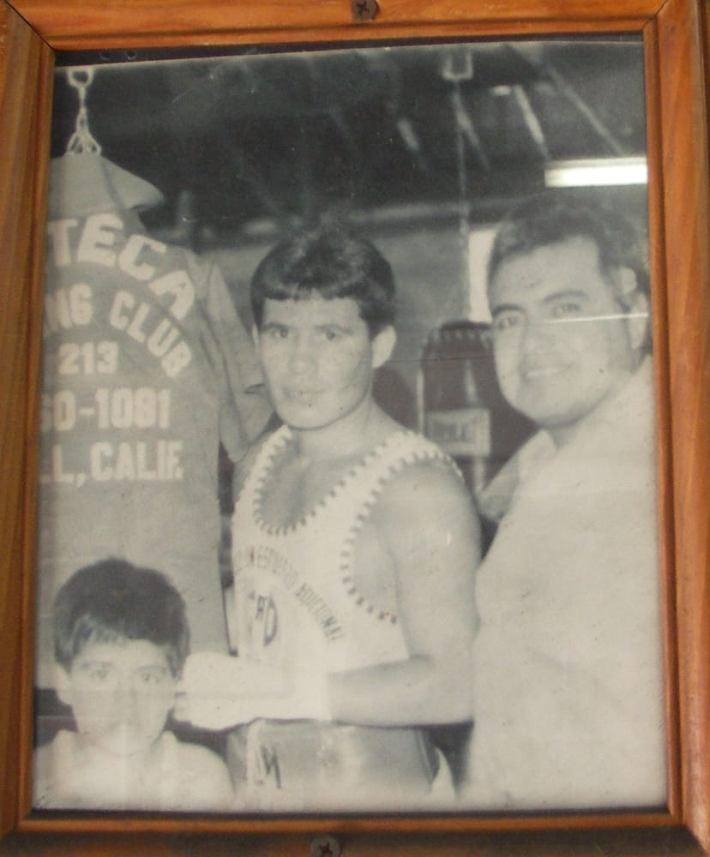
The Great Mexican Champion
[dropcap size=big]A[/dropcap]zteca gym members and enthusiasts still share memories of Chavez pulling up in his white luxury convertible as they waited in line just to get a glimpse of him training. The Sinaloa slugger – known simply by American media as “The Great Mexican Champion” – basically grew up there.
Chavez got his first major pro fight at age 17 in his adopted hometown Culiacan, in 1980, the same year Azteca opened its doors. Four years later and barely old enough to drink, Chavez won his first of six world championship titles on Olympic and Grand.
The Grand Olympic Auditorium where Chavez won the WBC Super Featherweight belt is now the Glory Church of Jesus Christ. But for his followers in Mexico and all over Los Angeles, Azteca was where their king of kings held court. El León de Culiacán won 89 fights before ever losing one.
RELATED: How Triple G Became An ‘Honorary Mexican’ In His Quest to Win Over L.A. Boxing Fans

The Macho Man
[dropcap size=big]A[/dropcap]zteca is also the gym where Puerto Rican legend Hector “Macho” Camacho trained when he became the WBC Lightweight Champion, after defeating Jose Luis “El Zurdo” Ramirez. Known as one of the best entertainers in boxing, Camacho would drive up in a red Lamborghini, just a bit more flashy than Chavez. He’d strut inside Azteca wearing a magnificent gold chain that read “Macho,” while fans and gym members looked in awe.
His charisma was undeniable, as he sparked laughter and smiles from gym members before, during, and after his sparring sessions. He was fond of yelling his signature line, “It’s Macho Time!”
In 1992, Camacho fought Chavez, in one of the most anticipated matches in the sport. Watching the muted Chavez come out to the ring and the flashy Camacho make a grand entrance was like watching Rocky versus Apollo Creed. Sadly for Camacho, he was one of Chavez’s 89 victims in the ring.
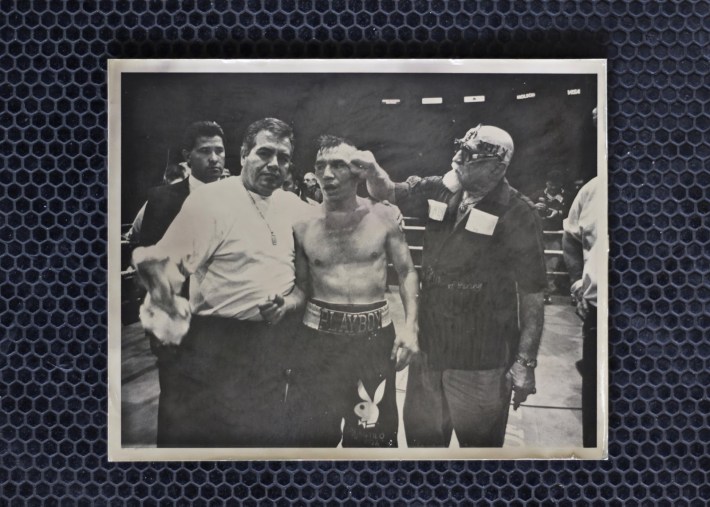
The Summersault Artist
[dropcap size=big]J[/dropcap]orge “El Maromero” Paez was another famous figure and a two-time world champion who trained at Azteca. Paez, from Mexicali, was adopted by his grandparents, who owned and ran “Circo Olvera.” Paez took his performance skills gained as a circus entertainer and flawlessly transferred them into the boxing world.
Many fans will remember his elaborate ring entrances. Very little people know, however, that a year before Dennis Rodman wore a wedding dress in 1996 to promote his new book, Paez sported a white dress and blasted the sounds of Mana’s “Estoy Agotado” during his ring entrance. This was surely his attempt to think outside the box and sensationally capture the crowd’s attention, which he did.
RELATED: MMA and Warren G: Why Live Fights and Music Could Be the Next Big Thing in Club Nights
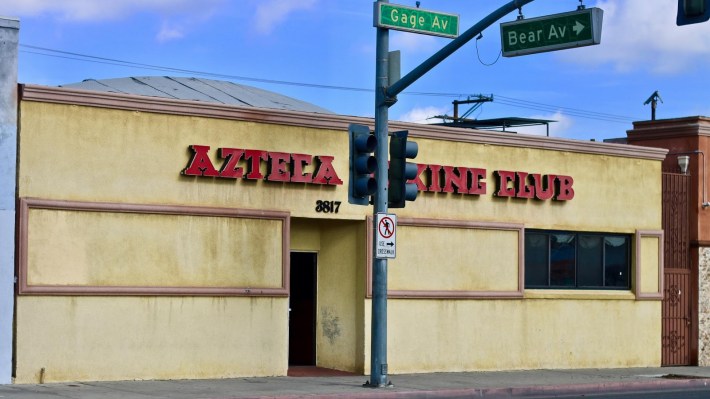
The Evolution of Southeast L.A.
[dropcap size=big]A[/dropcap]zteca Boxing Club is located in Bell, a small tight knit city that is tucked inside Southeast Los Angeles. It incorporated in 1927. Like all Southeast Los Angeles suburban communities established in the early 20th century, Bell was imagined as a living community for whites only. The development of Bell came with the help of federal funds.
According to UCLA professor Eric Avila, the post-WWII transformation of Dust Bowl communities in Southeast Los Angeles shows the “enfranchisement of the white working class.” Avila, who teaches Chicana/o Studies, told L.A. Taco that the early Bell residents “became the largest ‘welfare generation’ in the history of the United States.”
However, the 70s began a time of great deindustrialization and white flight. As whites began to leave the area, recent arrivals from Mexico and Central America settled in Bell, Bell Gardens, South Gate, and Huntington Park. They found work in non-union, low-wage jobs during a moment of dwindling tax bases and reduced social services. It was during this time that Arturo Mota, owner and founder of Azteca Boxing Club, moved to Bell.
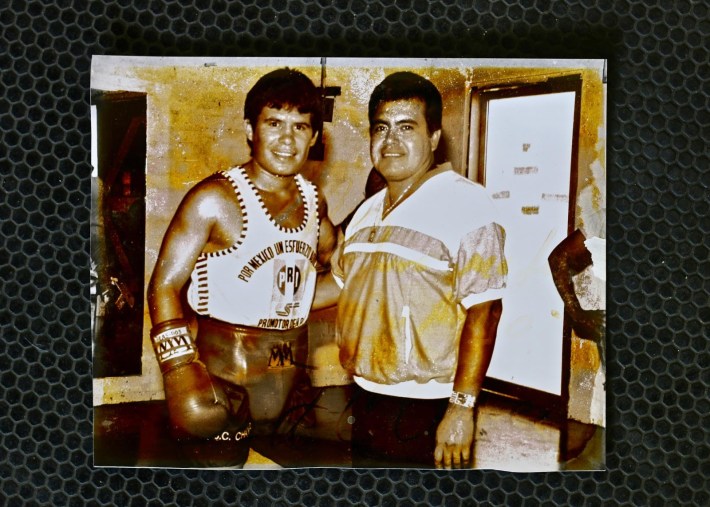
The Butcher
[dropcap size=big]M[/dropcap]ota migrated from Mexico City in search of better economic opportunities. With his expertise in butchery and an entrepreneurial spirit, he opened Azteca Meat Market on Gage Avenue in 1974. His son, Danny Mota, describes his father as a pioneer in the meat market business. More than just a business, Arturo created a space to shop where Latinos could feel welcome.
Bell at that moment was still a predominantly white community but changing. Opening Azteca Meat Market at the time was crucial, and it quickly drew in the incoming community. “There weren’t too many stores that catered to Latinos,” Danny told L.A. Taco. “So when he opened up a meat market, it was a booming business for him.”
'There weren’t too many stores that catered to Latinos'
The name “Azteca” itself was Arturo’s way of informing Latinos that his store catered to them.
With his meat market successfully running, Arturo decided to turn to boxing and planned to open a gym with his business partner. When his business partner backed down however, Arturo decided to continue with the project and opened Azteca Boxing Club right next-door to his meat market. What started out as a hobby for Arturo developed into the ownership of one of the most famous boxing gyms in sports history.
RELATED: My Favorite Taco ~ Jaime Jarrin, Dodgers Spanish Broadcaster
The Boxing Club
[dropcap size=big]W[/dropcap]hen Azteca opened in 1980, it was part of a cohort of private gyms that catered to professional boxers, due to the popularity of the sport in Los Angeles. Many marquee fights took place at The Forum in Inglewood and the Grand Olympic Auditorium in downtown. "It was kind of like the mecca of boxing,” Danny Mota recalled.
Thanks to boxers like Chavez, Azteca Boxing Club built its identity in that mecca as a staple institution of boxing, a place where champions were made. Mike Tyson, Top Rank founder Bob Arum, and the infamous Don King — to name a few — all made visits.
Azteca Boxing Club also experienced its share of struggles in the 1990s, a time where city-funded gyms flourished, and Chavez’s career entered its twilight.
Privately-owned gyms like Azteca had to lower their fees to match the new prices set by city gyms. And the sport was starting to shift out of L.A. to Las Vegas. The Grand Olympic Auditorium, where Chavez started his reign, reduced its capacity seating by 10,000 in 1993. It hosted its final boxing match in 2005, the same year Chavez had his final bout, finishing his career with 107 wins, six losses, and two draws.
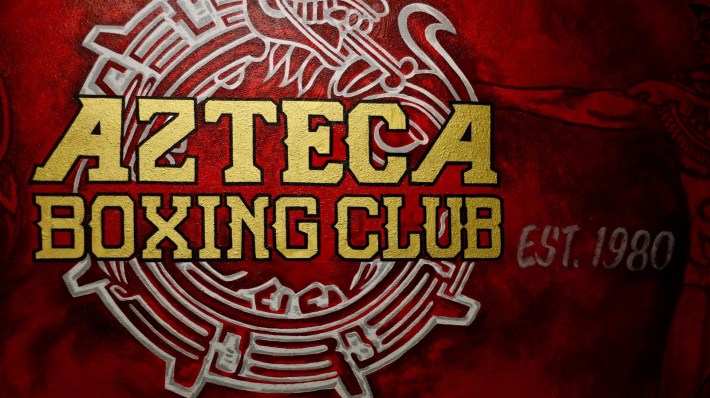
Despite these challenges in Los Angeles boxing history, Hall of Fame boxing historian and author Gene Aguilera told L.A. Taco this moment was also one of opportunity. “After the new Main Street Gym shut down for good in 1991, the Azteca Boxing Club quietly took over as the place where the new generation of Latino boxing legends went to train and spar.”
Azteca Boxing Club’s quiet takeover of Los Angeles boxing is important, especially during the recession that hit in the early 2000s. This moment of economic decline resulted in budget cuts for city boxing gyms. City gyms in Bell Gardens and Cudahy closed. As a privately-owned gym, Azteca found itself in a critical position to expand the ways it served the people of Bell.
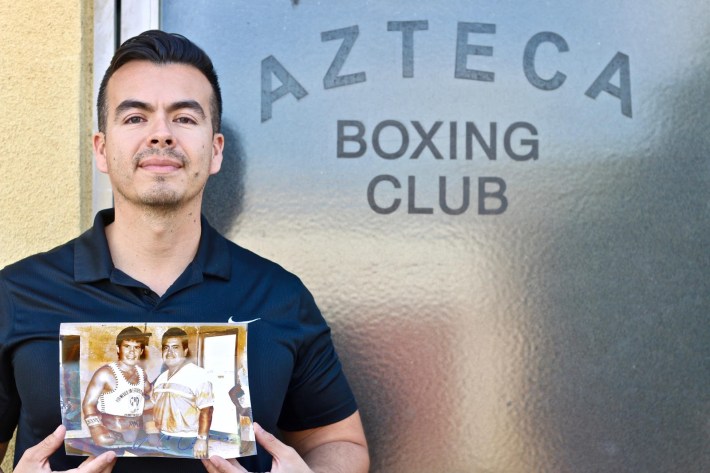
The Next Generation
[dropcap size=big]B[/dropcap]oxing gyms for a long time catered mostly to male professional fighters. More recently however, gyms like Azteca have become more inclusive to youth, girls, and women. In 2004, Danny Mota took over his father’s gym, bringing with him a new vision for the next generation. Although he maintains the spirit of Azteca as an authentic old-school purist boxing gym, Danny’s goal is to serve youth who are struggling and in need of support and guidance.
Pedro “Lil Pete” Duran, who is undefeated with 17 wins and three draws, is one of those youths who has benefited from Azteca Boxing Club. Duran, who enters the ring to the sounds of “DNA” by Kendrick Lamar, first stepped inside Azteca in 2002, when he was only eight years old. His father had been recently released from prison, and given his passion for boxing, suggested that his son try out the sport.
For Duran, Azteca is like a second home where he can be himself. “It’s the authenticity of the gym,” Duran told L.A. Taco. “And then it’s the history behind this gym. Everyone used to have their champs here, like Julio Cesar Chavez.”
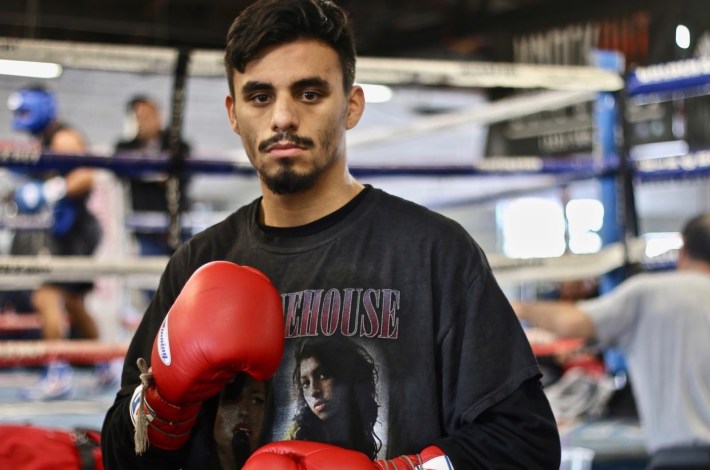
Though managing and catering to professional boxers is still emphasized by Azteca Boxing Club, Danny Mota is committed to his purpose of serving the youth of Bell. “The best feeling in the world is helping kids and providing a facility for them here in our area to do something positive," Danny told L.A. Taco. "What better way to do it than through a boxing gym?”
This is the legacy of Arturo Mota, who passed away in 2013. Azteca Boxing Club is one of the last of its kind, and like Chavez, Camacho, and the other champs that came through its ropes, the legend lives to fight on in immortality.
RELATED: We Had to Hang Out in Person ~ An Oral History of the Heyday in Nineties Hollywood
